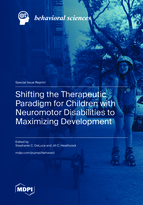Shifting the Therapeutic Paradigm for Children with Neuromotor Disabilities to Maximizing Development
A special issue of Behavioral Sciences (ISSN 2076-328X). This special issue belongs to the section "Developmental Psychology".
Deadline for manuscript submissions: closed (10 July 2023) | Viewed by 24884
Special Issue Editors
Interests: cerebral palsy; neuromotor disorders; neuroscience; pediatrics
Special Issue Information
Dear Colleagues,
The United Nations Convention on the Rights to Children states that “Every child with a disability should enjoy the best possible life in society. Governments should remove all obstacles for children with disabilities to become independent and to participate actively in the community.” This is a multicontextual and complicated call, and there are many seeking to address this call across healthcare and rehabilitation, but both systems still struggle with a legacy of a medical model that often interferes with these goals. In this Special Issue we will focus our attention on neuromotor disabilities and seek to understand and better define what it means for a child with a neuromotor disability to enjoy the best life possible by maximizing independence and societal participation. We will also explore if the current models of diagnosis and treatment are adequately considering how to truly maximize the development of children with neuromotor disabilities. We welcome articles that consider current trends and changing paradigms based on high-quality scientific evidence in both the early diagnosis and treatment of neuromotor disabilities. We also welcome empirical submissions that help better define the path for future researchers, clinicians, and families who are seeking to maximize the development of children with neuromotor disabilities.
Focus of interest (but not limited to):
- Cerebral palsy
- Neuromotor disabilities
- Neuromuscular conditions
- Genetic diagnosis
- Early acquired brain injury
- Stroke
- Preterm birth
DEIA statement: We support all aspects of diversity, equity, inclusion, and accessibility (DEIA) in our lives and work; as such, we expect all proposed authors to address DEIA in their proposed submission. This is crucial for many reasons, but particularly for children with disabilities in promoting the rights of all children to have an inclusive life experience.
Dr. Stephanie C. DeLuca
Dr. Jill C. Heathcock
Guest Editors
Manuscript Submission Information
Manuscripts should be submitted online at www.mdpi.com by registering and logging in to this website. Once you are registered, click here to go to the submission form. Manuscripts can be submitted until the deadline. All submissions that pass pre-check are peer-reviewed. Accepted papers will be published continuously in the journal (as soon as accepted) and will be listed together on the special issue website. Research articles, review articles as well as short communications are invited. For planned papers, a title and short abstract (about 100 words) can be sent to the Editorial Office for announcement on this website.
Submitted manuscripts should not have been published previously, nor be under consideration for publication elsewhere (except conference proceedings papers). All manuscripts are thoroughly refereed through a single-blind peer-review process. A guide for authors and other relevant information for submission of manuscripts is available on the Instructions for Authors page. Behavioral Sciences is an international peer-reviewed open access monthly journal published by MDPI.
Please visit the Instructions for Authors page before submitting a manuscript. The Article Processing Charge (APC) for publication in this open access journal is 2200 CHF (Swiss Francs). Submitted papers should be well formatted and use good English. Authors may use MDPI's English editing service prior to publication or during author revisions.
Keywords
- rehabilitation
- pediatrics
- developmental science
- technology
- outcomes across the lifespan
- systems of care
- complexity
- multiple developmental domains
- early diagnosis
- early intervention
- assessment and Treatment
- methodology
- biobehavioral marker
- motor learning and plasticity
- brain-behavior relationships







